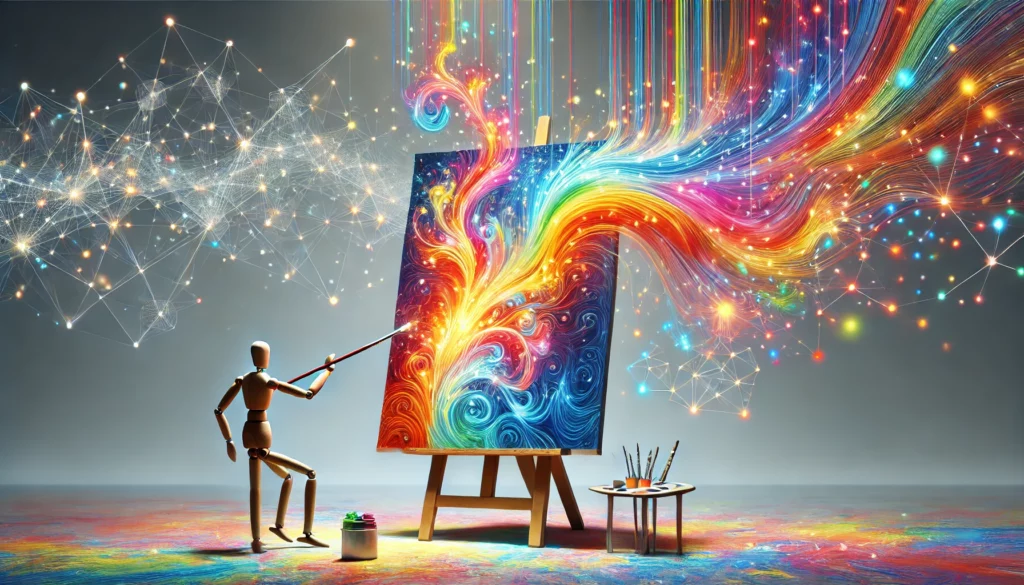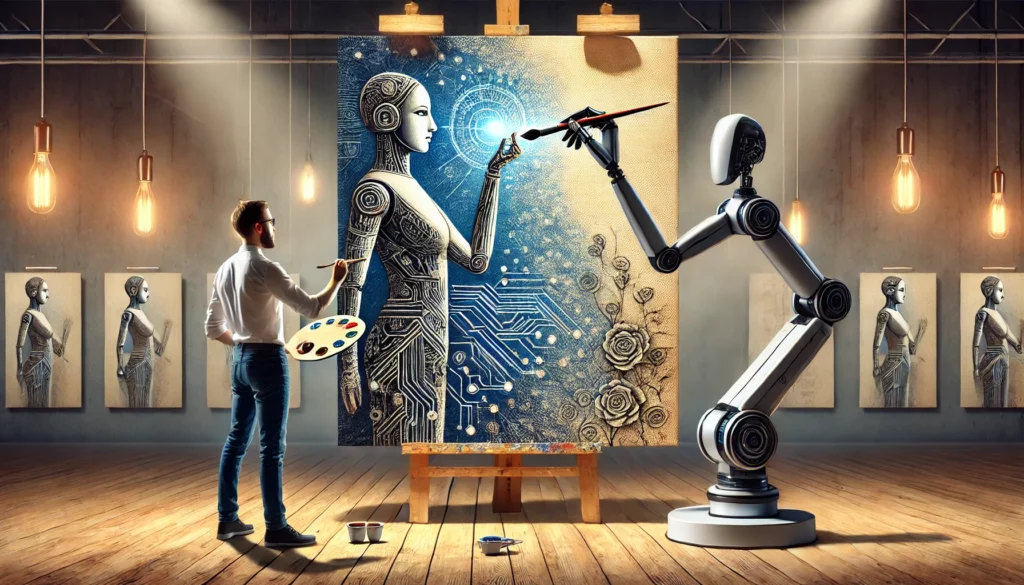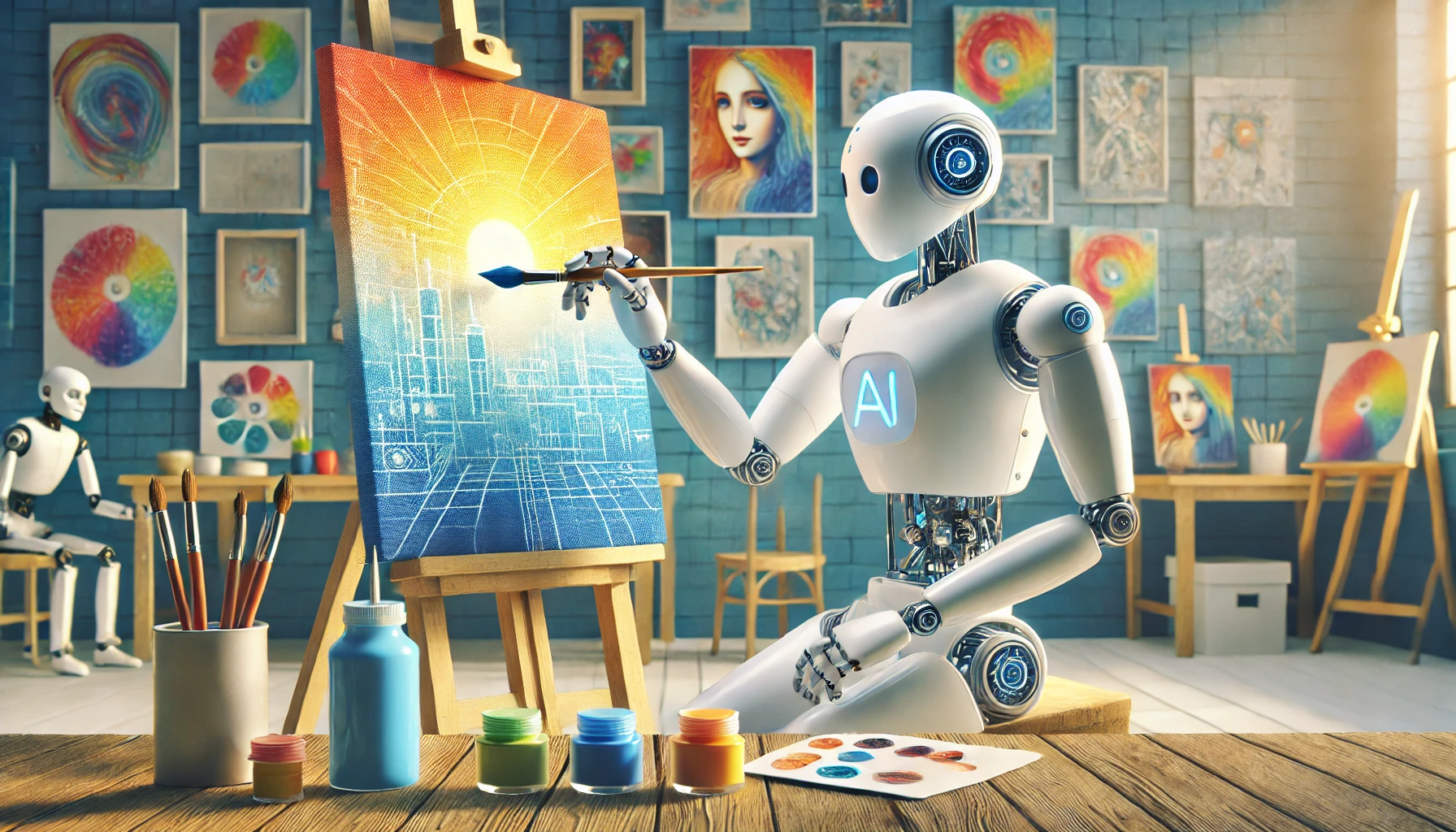The Evolution of AI in Art
The journey of AI in art began with early experiments aimed at understanding if machines could mimic human creativity. One notable milestone was Harold Cohen’s AARON, a computer program developed in the 1970s to produce drawings autonomously. Since then, advancements in machine learning and neural networks have significantly expanded AI’s capabilities in art creation.
Prominent AI art projects like Google’s DeepDream and OpenAI’s DALL-E have pushed boundaries, generating artwork that is both innovative and reflective of complex patterns and styles. These projects have not only showcased the potential of AI in creating visually stunning pieces but have also sparked discussions on the nature of creativity and artistic expression (AIgantic) (AI for Social Good).
How AI Creates Art
AI-generated art is predominantly powered by advanced algorithms and neural networks. Key technologies include:
- Machine Learning: Algorithms learn from vast datasets of existing artworks to identify patterns and styles.
- Neural Networks: These mimic the human brain’s structure, enabling AI to process and generate art. Generative Adversarial Networks (GANs), where two neural networks—one generating art and the other evaluating it—are particularly influential in creating high-quality artwork (Palpx).
- Deep Learning: This subset of machine learning uses multiple layers to analyze and generate complex artistic styles and compositions (Moments Log).
Tools like DeepArt and RunwayML allow artists to leverage these technologies, creating art that ranges from paintings to music compositions. Case studies, such as AI-generated portraits that have fetched high prices at auctions, illustrate the significant impact and potential of AI in the art world (AIgantic).
Debating AI as Artists
The question of whether AI can be considered artists is contentious. Proponents argue that AI exhibits creativity and originality by generating novel and intricate pieces of art. AI’s ability to learn from vast datasets and innovate on artistic styles suggests a form of creativity that, while different from human creativity, is still valuable.
However, critics highlight that AI lacks the emotional depth and subjective experience inherent in human art. They argue that AI-generated art, though visually impressive, may lack the emotional authenticity and narrative that come from human experiences and cultural contexts (AI for Social Good).
The philosophical and ethical implications are significant. The role of human input in guiding AI, the authorship of AI-created works, and the potential biases in AI-generated art are critical considerations. AI art creation is not entirely autonomous; human artists often play a crucial role in training and fine-tuning the algorithms, suggesting a collaborative rather than a competitive relationship between humans and machines (Moments Log).
Impact on the Art Community
AI art has had a mixed reception in the traditional art community. While some critics and artists view it as a valuable new medium that expands creative possibilities, others are skeptical of its artistic merit. The art market has also begun to recognize AI-generated art, with pieces being auctioned and collected, sometimes fetching substantial sums.

Contemporary art practices are increasingly incorporating AI tools, leading to innovative hybrid forms of art that blend human creativity with machine precision. This integration is reshaping how art is created, perceived, and valued (Palpx).
AI in Art and Creativity: Exploring the Role of Machines as Artists
The Evolution of AI in Art
The journey of AI in art began with early experiments aimed at understanding if machines could mimic human creativity. One notable milestone was Harold Cohen’s AARON, a computer program developed in the 1970s to produce drawings autonomously. Since then, advancements in machine learning and neural networks have significantly expanded AI’s capabilities in art creation.
Prominent AI art projects like Google’s DeepDream and OpenAI’s DALL-E have pushed boundaries, generating artwork that is both innovative and reflective of complex patterns and styles. These projects have not only showcased the potential of AI in creating visually stunning pieces but have also sparked discussions on the nature of creativity and artistic expression (AIgantic) (AI for Social Good).
How AI Creates Art
AI-generated art is predominantly powered by advanced algorithms and neural networks. Key technologies include:
- Machine Learning: Algorithms learn from vast datasets of existing artworks to identify patterns and styles.
- Neural Networks: These mimic the human brain’s structure, enabling AI to process and generate art. Generative Adversarial Networks (GANs), where two neural networks—one generating art and the other evaluating it—are particularly influential in creating high-quality artwork (Palpx).
- Deep Learning: This subset of machine learning uses multiple layers to analyze and generate complex artistic styles and compositions (Moments Log).
Tools like DeepArt and RunwayML allow artists to leverage these technologies, creating art that ranges from paintings to music compositions. Case studies, such as AI-generated portraits that have fetched high prices at auctions, illustrate the significant impact and potential of AI in the art world (AIgantic).
Debating AI as Artists
The question of whether AI can be considered artists is contentious. Proponents argue that AI exhibits creativity and originality by generating novel and intricate pieces of art. AI’s ability to learn from vast datasets and innovate on artistic styles suggests a form of creativity that, while different from human creativity, is still valuable.

However, critics highlight that AI lacks the emotional depth and subjective experience inherent in human art. They argue that AI-generated art, though visually impressive, may lack the emotional authenticity and narrative that come from human experiences and cultural contexts (AI for Social Good).
The philosophical and ethical implications are significant. The role of human input in guiding AI, the authorship of AI-created works, and the potential biases in AI-generated art are critical considerations. AI art creation is not entirely autonomous; human artists often play a crucial role in training and fine-tuning the algorithms, suggesting a collaborative rather than a competitive relationship between humans and machines (Moments Log).
Impact on the Art Community
AI art has had a mixed reception in the traditional art community. While some critics and artists view it as a valuable new medium that expands creative possibilities, others are skeptical of its artistic merit. The art market has also begun to recognize AI-generated art, with pieces being auctioned and collected, sometimes fetching substantial sums.
Contemporary art practices are increasingly incorporating AI tools, leading to innovative hybrid forms of art that blend human creativity with machine precision. This integration is reshaping how art is created, perceived, and valued (Palpx).
Future Prospects
The future of AI in art holds exciting possibilities. Advancements in AI technology could lead to even more sophisticated and autonomous art creation processes. As AI continues to evolve, it may develop new forms of artistic expression that are currently unimaginable.
Predictions suggest that AI will increasingly act as a collaborator, enhancing human creativity rather than replacing it. The relationship between human artists and AI is likely to become more integrated, with AI tools becoming a standard part of the artistic toolkit (AIgantic) (AI for Social Good).
Conclusion
AI’s role in art and creativity is a fascinating and evolving narrative. While debates about AI’s ability to truly be creative continue, its impact on the art world is undeniable. The future of AI in art promises further innovation, challenging our perceptions of creativity and expanding the horizons of artistic expression.
FAQs on AI in Art and Creativity: Exploring the Role of Machines as Artists
1. What is AI-generated art?
AI-generated art refers to artwork created using artificial intelligence technologies, such as machine learning algorithms and neural networks. These technologies analyze existing art data to create new and original pieces of art. Examples include Google’s DeepDream and OpenAI’s DALL-E, which generate images based on patterns learned from vast datasets (AIgantic) (Moments Log).
2. How do neural networks contribute to AI art?
Neural networks are integral to AI art creation. They mimic the structure of the human brain, enabling AI to process and generate complex artistic styles. Generative Adversarial Networks (GANs) are particularly influential, consisting of two networks: one generates art, while the other evaluates it. This competition results in the creation of high-quality, original artwork (Palpx) (Moments Log).
3. Can AI be considered a true artist?
The debate on whether AI can be considered a true artist is ongoing. Proponents argue that AI can exhibit creativity and originality, producing novel and intricate pieces of art. Critics, however, highlight that AI lacks the emotional depth and subjective experiences that human artists bring to their work. They argue that AI-generated art may lack the emotional authenticity found in human-created art (AI for Social Good) (Moments Log).
4. What impact does AI art have on traditional artists?
AI art has a mixed reception among traditional artists. Some view it as a valuable new medium that expands creative possibilities, while others are skeptical of its artistic merit. AI art is increasingly recognized in the art market, with AI-generated pieces being auctioned and collected. This integration is reshaping how art is created, perceived, and valued in the contemporary art scene (Palpx) (Moments Log).
